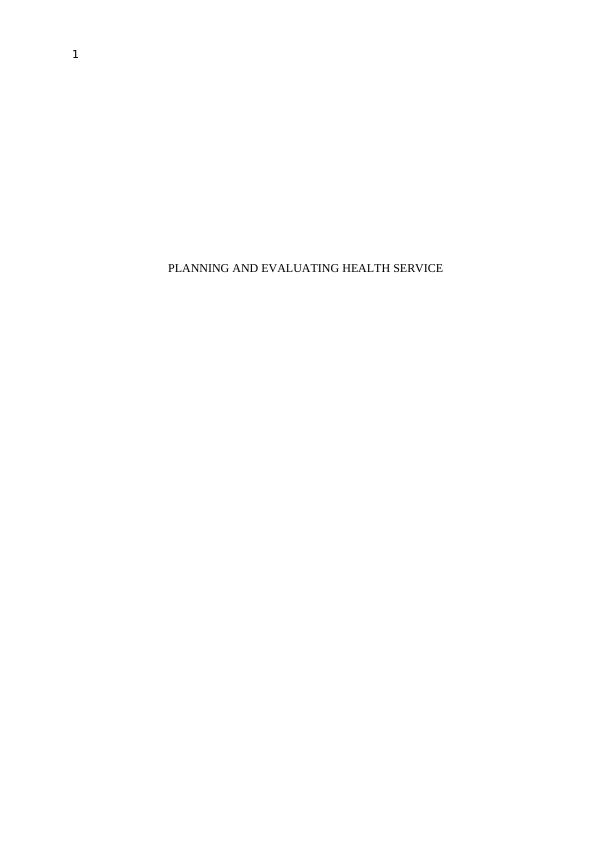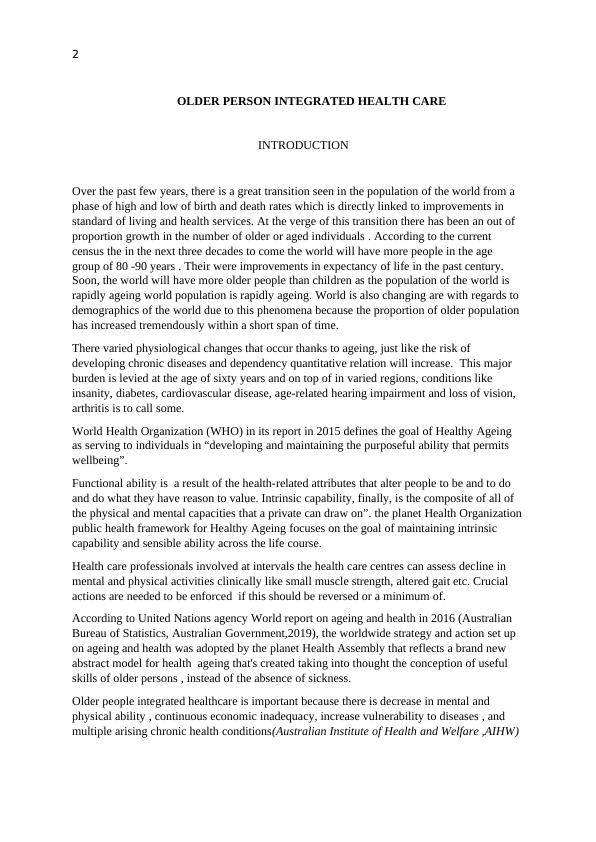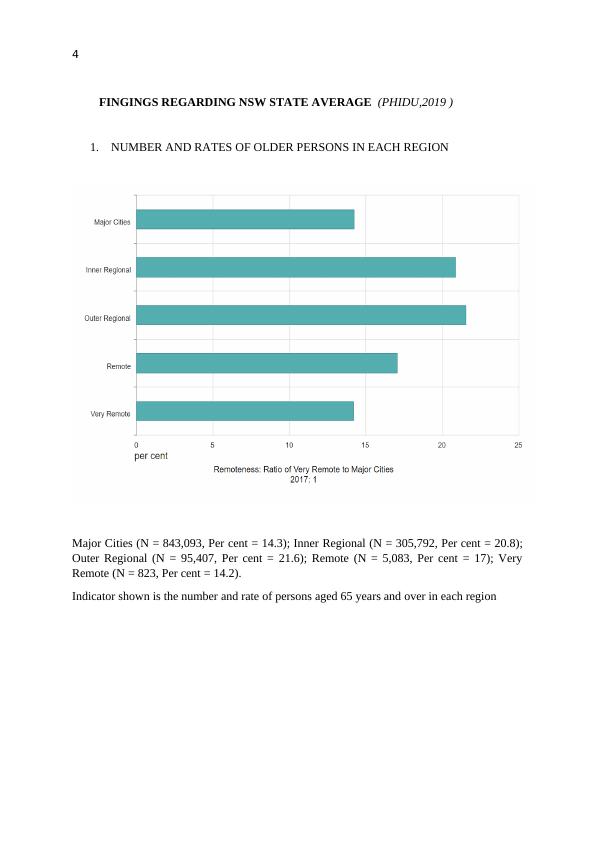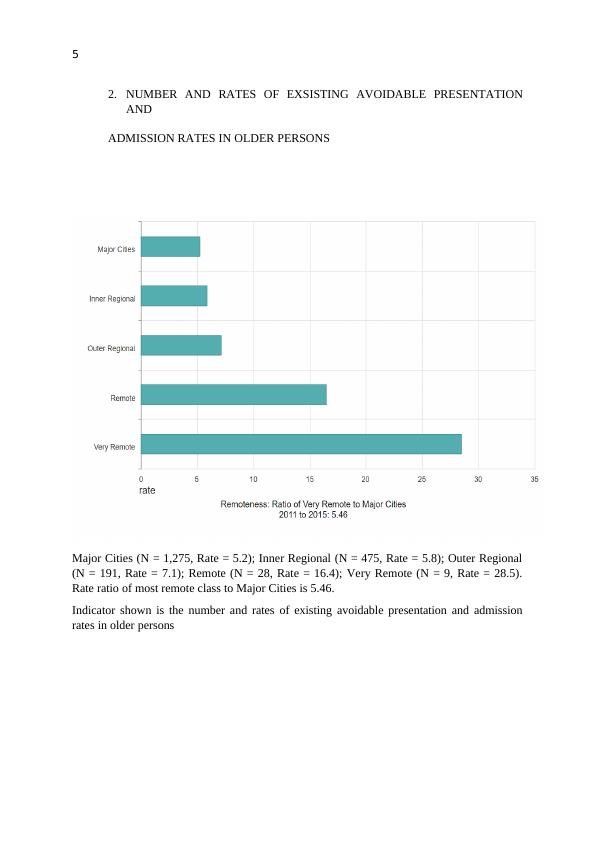Planning and Evaluating Health Service for Older Person Integrated Health Care
Added on 2022-12-26
21 Pages4761 Words48 Views
1
PLANNING AND EVALUATING HEALTH SERVICE
PLANNING AND EVALUATING HEALTH SERVICE

2
OLDER PERSON INTEGRATED HEALTH CARE
INTRODUCTION
Over the past few years, there is a great transition seen in the population of the world from a
phase of high and low of birth and death rates which is directly linked to improvements in
standard of living and health services. At the verge of this transition there has been an out of
proportion growth in the number of older or aged individuals . According to the current
census the in the next three decades to come the world will have more people in the age
group of 80 -90 years . Their were improvements in expectancy of life in the past century.
Soon, the world will have more older people than children as the population of the world is
rapidly ageing world population is rapidly ageing. World is also changing are with regards to
demographics of the world due to this phenomena because the proportion of older population
has increased tremendously within a short span of time.
There varied physiological changes that occur thanks to ageing, just like the risk of
developing chronic diseases and dependency quantitative relation will increase. This major
burden is levied at the age of sixty years and on top of in varied regions, conditions like
insanity, diabetes, cardiovascular disease, age-related hearing impairment and loss of vision,
arthritis is to call some.
World Health Organization (WHO) in its report in 2015 defines the goal of Healthy Ageing
as serving to individuals in “developing and maintaining the purposeful ability that permits
wellbeing”.
Functional ability is a result of the health-related attributes that alter people to be and to do
and do what they have reason to value. Intrinsic capability, finally, is the composite of all of
the physical and mental capacities that a private can draw on”. the planet Health Organization
public health framework for Healthy Ageing focuses on the goal of maintaining intrinsic
capability and sensible ability across the life course.
Health care professionals involved at intervals the health care centres can assess decline in
mental and physical activities clinically like small muscle strength, altered gait etc. Crucial
actions are needed to be enforced if this should be reversed or a minimum of.
According to United Nations agency World report on ageing and health in 2016 (Australian
Bureau of Statistics, Australian Government,2019), the worldwide strategy and action set up
on ageing and health was adopted by the planet Health Assembly that reflects a brand new
abstract model for health ageing that's created taking into thought the conception of useful
skills of older persons , instead of the absence of sickness.
Older people integrated healthcare is important because there is decrease in mental and
physical ability , continuous economic inadequacy, increase vulnerability to diseases , and
multiple arising chronic health conditions(Australian Institute of Health and Welfare ,AIHW)
OLDER PERSON INTEGRATED HEALTH CARE
INTRODUCTION
Over the past few years, there is a great transition seen in the population of the world from a
phase of high and low of birth and death rates which is directly linked to improvements in
standard of living and health services. At the verge of this transition there has been an out of
proportion growth in the number of older or aged individuals . According to the current
census the in the next three decades to come the world will have more people in the age
group of 80 -90 years . Their were improvements in expectancy of life in the past century.
Soon, the world will have more older people than children as the population of the world is
rapidly ageing world population is rapidly ageing. World is also changing are with regards to
demographics of the world due to this phenomena because the proportion of older population
has increased tremendously within a short span of time.
There varied physiological changes that occur thanks to ageing, just like the risk of
developing chronic diseases and dependency quantitative relation will increase. This major
burden is levied at the age of sixty years and on top of in varied regions, conditions like
insanity, diabetes, cardiovascular disease, age-related hearing impairment and loss of vision,
arthritis is to call some.
World Health Organization (WHO) in its report in 2015 defines the goal of Healthy Ageing
as serving to individuals in “developing and maintaining the purposeful ability that permits
wellbeing”.
Functional ability is a result of the health-related attributes that alter people to be and to do
and do what they have reason to value. Intrinsic capability, finally, is the composite of all of
the physical and mental capacities that a private can draw on”. the planet Health Organization
public health framework for Healthy Ageing focuses on the goal of maintaining intrinsic
capability and sensible ability across the life course.
Health care professionals involved at intervals the health care centres can assess decline in
mental and physical activities clinically like small muscle strength, altered gait etc. Crucial
actions are needed to be enforced if this should be reversed or a minimum of.
According to United Nations agency World report on ageing and health in 2016 (Australian
Bureau of Statistics, Australian Government,2019), the worldwide strategy and action set up
on ageing and health was adopted by the planet Health Assembly that reflects a brand new
abstract model for health ageing that's created taking into thought the conception of useful
skills of older persons , instead of the absence of sickness.
Older people integrated healthcare is important because there is decrease in mental and
physical ability , continuous economic inadequacy, increase vulnerability to diseases , and
multiple arising chronic health conditions(Australian Institute of Health and Welfare ,AIHW)

3
WORLD POPULATION TREND OF 65 YEARS AND ABOVE FROM 1980-2020 (in
millions)
(United Nations, World Demographic Estimate and Projections)
WORLD POPULATION TREND OF 65 YEARS AND ABOVE FROM 1980-2020 (in
millions)
(United Nations, World Demographic Estimate and Projections)

4
FINGINGS REGARDING NSW STATE AVERAGE (PHIDU,2019 )
1. NUMBER AND RATES OF OLDER PERSONS IN EACH REGION
Major Cities (N = 843,093, Per cent = 14.3); Inner Regional (N = 305,792, Per cent = 20.8);
Outer Regional (N = 95,407, Per cent = 21.6); Remote (N = 5,083, Per cent = 17); Very
Remote (N = 823, Per cent = 14.2).
Indicator shown is the number and rate of persons aged 65 years and over in each region
FINGINGS REGARDING NSW STATE AVERAGE (PHIDU,2019 )
1. NUMBER AND RATES OF OLDER PERSONS IN EACH REGION
Major Cities (N = 843,093, Per cent = 14.3); Inner Regional (N = 305,792, Per cent = 20.8);
Outer Regional (N = 95,407, Per cent = 21.6); Remote (N = 5,083, Per cent = 17); Very
Remote (N = 823, Per cent = 14.2).
Indicator shown is the number and rate of persons aged 65 years and over in each region

5
2. NUMBER AND RATES OF EXSISTING AVOIDABLE PRESENTATION
AND
ADMISSION RATES IN OLDER PERSONS
Major Cities (N = 1,275, Rate = 5.2); Inner Regional (N = 475, Rate = 5.8); Outer Regional
(N = 191, Rate = 7.1); Remote (N = 28, Rate = 16.4); Very Remote (N = 9, Rate = 28.5).
Rate ratio of most remote class to Major Cities is 5.46.
Indicator shown is the number and rates of existing avoidable presentation and admission
rates in older persons
2. NUMBER AND RATES OF EXSISTING AVOIDABLE PRESENTATION
AND
ADMISSION RATES IN OLDER PERSONS
Major Cities (N = 1,275, Rate = 5.2); Inner Regional (N = 475, Rate = 5.8); Outer Regional
(N = 191, Rate = 7.1); Remote (N = 28, Rate = 16.4); Very Remote (N = 9, Rate = 28.5).
Rate ratio of most remote class to Major Cities is 5.46.
Indicator shown is the number and rates of existing avoidable presentation and admission
rates in older persons

6
3. NUMBER AND RATES OF AT RISK POPULATION FOR AVOIDABLE
PRESENTATIONS /ADMISSIONS IN OLDER PERSONS
Major Cities (N = 26,799, Rate = 107.7); Inner Regional (N = 10,320, Rate = 135.6); Outer
Regional (N = 3,799, Rate = 153); Remote (N = 366, Rate = 226.7); Very Remote (N = 89,
Rate = 292.6). Rate ratio of most remote class to Major Cities is 2.72.
Indicator shown is the number and rates of at risk population for avoidable presentations /
admissions in older person .
3. NUMBER AND RATES OF AT RISK POPULATION FOR AVOIDABLE
PRESENTATIONS /ADMISSIONS IN OLDER PERSONS
Major Cities (N = 26,799, Rate = 107.7); Inner Regional (N = 10,320, Rate = 135.6); Outer
Regional (N = 3,799, Rate = 153); Remote (N = 366, Rate = 226.7); Very Remote (N = 89,
Rate = 292.6). Rate ratio of most remote class to Major Cities is 2.72.
Indicator shown is the number and rates of at risk population for avoidable presentations /
admissions in older person .

End of preview
Want to access all the pages? Upload your documents or become a member.
Related Documents
Supporting Aged Communitieslg...
|15
|4469
|112
Why is healthy ageing important to individuals?lg...
|4
|508
|363
Primary Health Care for Older Adults in Australialg...
|9
|2551
|71
Primary Health Care in Australialg...
|7
|1591
|44
Community Health Care in Nursing: Demographics, Health Issues, and Social Determinants of Health (SDoH)lg...
|12
|3195
|53
The Coalition’s Policy for Healthy Life, Better Ageinglg...
|10
|1289
|162